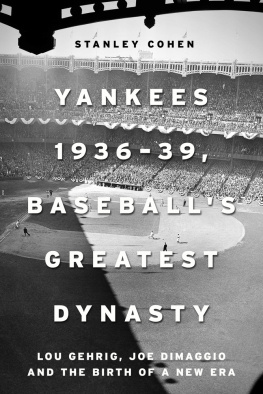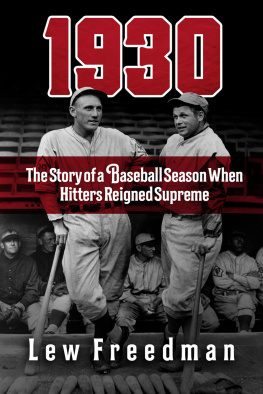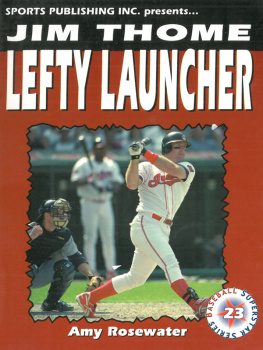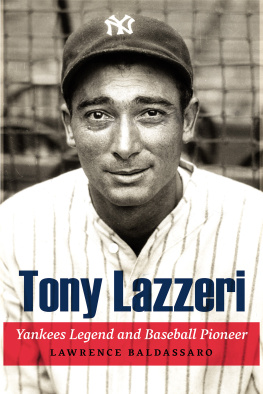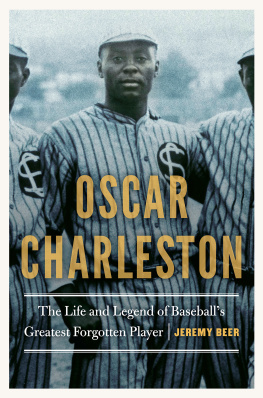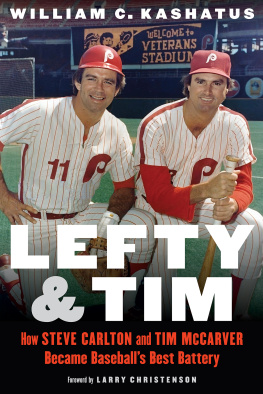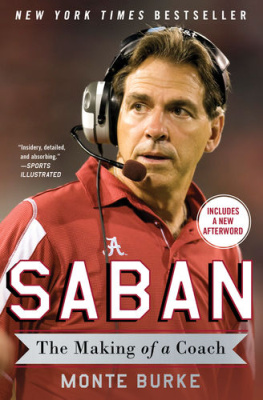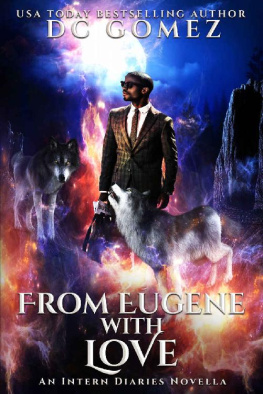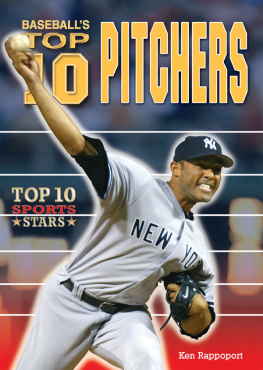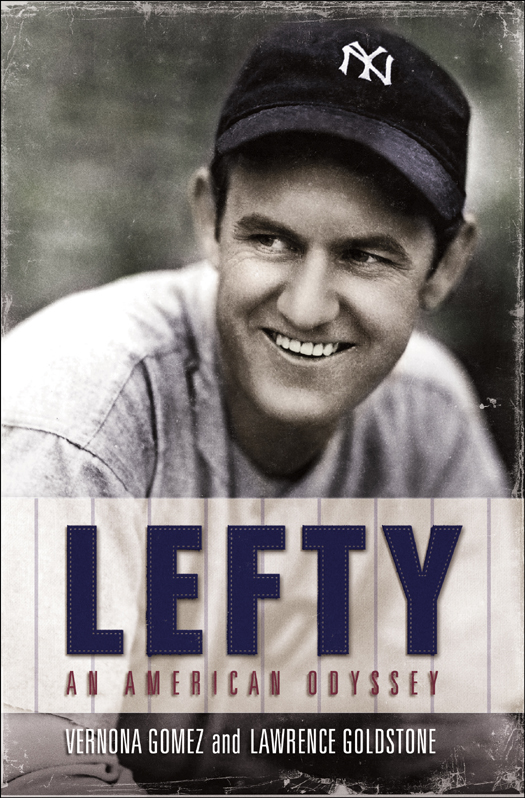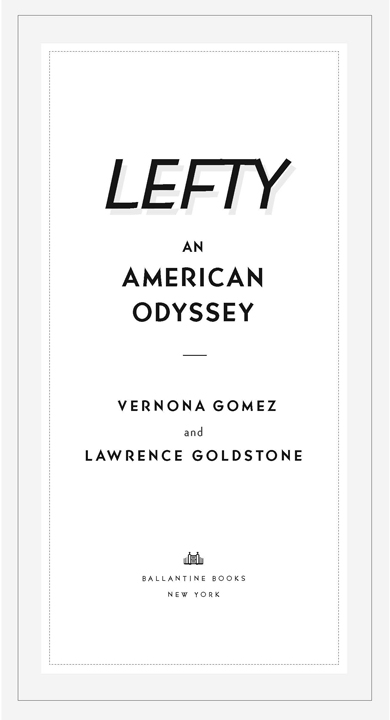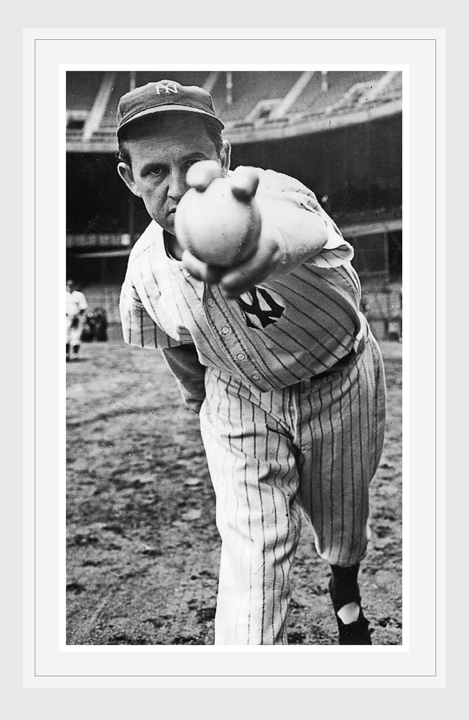
Copyright 2012 by Vernona Gomez
All rights reserved.
Published in the United States by Ballantine Books,
an imprint of The Random House Publishing Group,
a division of Random House, Inc., New York.
B ALLANTINE and colophon are registered
trademarks of Random House, Inc.
LIBRARAY OF CONGRESS CATALOGING-IN-PUBLICATION DATA
Gomez, Vernona.
Lefty : an American odyssey /
Vernona Gomez and Lawrence Goldstone.
p. cm.
eISBN: 978-0-345-52650-2
1. Gomez, Vernon, 19081989. 2. Baseball players
United StatesBiography. 3. Pitchers (Baseball)
United StatesBiography.
I. Goldstone, Lawrence. II. Title.
GV865.G59A3 2012
796.357092dc23 [B] 2012004000
www.ballantinebooks.com
Title page photograph of Lefty Gomez in 1937
copyright Bettman/Corbis
Part title photographs on
from the Associated Press
Photograph on copyright 2011
by Vernon Lefty Gomez LLC. All rights reserved
v3.1
For June and Leftys grandchildren:
John, Andrew, Scott, Vernona Elizabeth,
Jennifer, Serena, and Tiffany

PREFACE

P enning his biography would never have occurred to Lefty. When asked, he would reply, Why would I write a book about my life? I lived it. But in the 1950s, the literary seed was planted due to a chance encounter with two icons of the publishing world, Bennett Cerf, the co-founder of Random House, and James Michener, one of Cerfs baseball-loving authors.
While a mystery guest on the television show Whats My Line? Lefty met Cerf, one of the shows panelists. He asked Lefty for his autograph as a surprise gift for one of his authors, James Michener. Upon receiving the autograph, Michener rang Lefty up, and a lifelong friendship began. Listening to Leftys tales, Michener would often chuckle and say, The old West. The roaring East. Baseball. Broadway. That life of yours is the dream of every American boy.
In 1978, Lefty was on location for the filming of Centennial , Micheners runaway bestseller about the American West, to say hello to Jim and the actors on the set. As Lefty explained: Jim autographed a copy of his book to me, which is a treasure in my library. To Lefty Gomez, from a writer who has always loved baseball and who often saw you pitch. Aloha, Jim Michener.
Then Jim surprised me by saying, Lefty. Lets write your life story. But it was never to be, only for the fact that I couldnt find the time to sit down with Jim and do that endless chatting that is so necessary for a book to come about. One day my daughter Vernona said, Okay, Dad, Im not Michener, but we bump into each other a lot. Lets write that life of yours. And thats how this book came to be.
Sixty years after Lefty first shook hands with Bennett Cerf on the set of Whats My Line? the seed planted by Michener blossomed in a New York conference room when Ballantine Books, a Random House affiliate, met with me and offered to publish Lefty: An American Odyssey. It has been a delight working on this project with them.
CONTENTS

AMERICAS PASTIME
FOR BAREFOOT BOYS

WHAT DO YOU THINK OF
MY BOY VERNON NOW?

WHEN I MARRIED LEFTY,
I MARRIED BASEBALL

PROLOGUE

O n Saturday, August 4, 1962, 30,000 fans crowded into Candlestick Park in San Francisco to see the Giants defeat the Pittsburgh Pirates 65. The Giants were new to the city, one of two major league franchises from New York that had arrived in California in 1958, a century after professional baseball began. The Brooklyn Dodgers had also moved to the West Coast, settling in Los Angeles, 400 miles to the south.
Large crowds were uncommon at Candlestick, an uncomfortable, hastily designed stadium known for violent, swirling winds. During the All-Star Game the year before, Stu Miller had been blown off the pitchers mound by a powerful gust and charged with a balk. Although the Giants would go on to win the 1962 National League pennant and then lose to the New York Yankees four games to three in a thrilling World Series, the team would average only 19,000 paying spectators per game. The reason 30,000 people had come out on this day was to see not the players of the present but those of the past. The Giants had chosen August 4 to stage their first-ever Old-Timers Game. To evoke the nostalgia crucial to the success of such an event, the three-inning contest would pit the old New York Giants against veterans of the San Francisco Seals of the Pacific Coast League.
The Giants might have been storied in New York, but the Seals were the legends in San Francisco. Minor league baseball had grown with the city since 1903, through earthquake, depression, and wars, filling a series of intimate, rickety ballparks, and was a part of both the citys heritage and its fabric. For California boys growing up in the 1920s and 1930s, the majors were as removed from their lives as if on another continent. With only sixteen big league teams, the farthest west 1,500 miles away in St. Louis, with no air travel or live broadcast media, the closest Depression-era Bay Area fans could come to the majors was through newspaper accounts or radio re-creations read by local sportswriters off telegraph wires. And such was the quality of Pacific Coast League baseball that some players preferred remaining where they were to going east to play in the majors.
The Seals themselves had been the most successful franchise in minor league history, and not all San Franciscans had been pleased to see the team fold after the 1957 season to make way for the New Yorkers. In its fifty-four-year history, the Seals had finished first in a highly competitive league on twelve occasions, all while sending a steady stream of star players to the majors. Six Seals alumni had been voted into the Hall of Fame, more than some major league franchises.
Which is why, on August 4, 1962, desperate to fill some seats, the new San Francisco Giants chose to celebrate the team that it had displaced.
The Seals starting outfield was a big reason the Candlestick stands were full. For the first time in their storied careers, the three DiMaggio brothers would play together: Dom in left, Vince in right, and, in center, the great Joe, The Yankee Clipper, perhaps the most complete player ever to don a uniform. The Seals starting pitcher would be another Hall of Famer and a local legend in his own right: Joes old Yankee roommate, Vernon Lefty Gomez.


